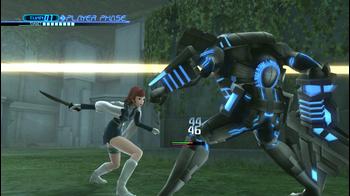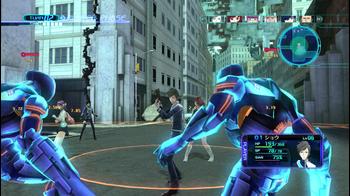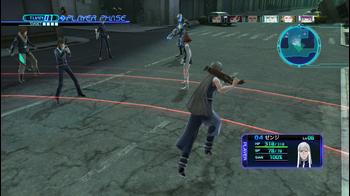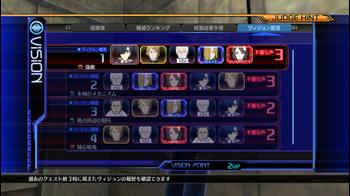
Lost Dimension Review
Atlus USA has kept pretty busy as of late. In addition to their efforts on English versions of Persona, Shin Megami Tensei, and Etrian series titles, the publisher has also taken on the task of localizing several niche Japanese titles from other developers. Such is the case with Lancarse’s Lost Dimension, a different sort of JRPG.
Lost Dimension doesn’t take long to get things going. After a short animated introduction, the game throws you into a tutorial battle against machine-like enemies. You take the viewpoint of Sho Kasugai, an 18-year-old who finds himself teaming up with ten other young soldiers. Each of these characters wields a unique psychic ability. Sho, for example, has the ability of foresight, and other characters hold special ‘gifts’ such as telepathy, telekinesis, pyrokinesis, and teleportation, among others.
This gifted cast soon learns that they are tasked to stopping a mysterious being known only as “The End”. This terrorist villain has suddenly appeared along with a tall pillar in the middle of the city. ‘The End’ threatens to bring the world to, well, an end, and it’s up to Sho and the rest to scale the tower to stop him.
Lost Dimension is a turn-based RPG, which at first glance resembles something similar to Valkyria Chronicles. The game is divided into missions, and you select a team of six and place them at pre-determined positions on the battlefield map. Once combat starts, each character takes a turn to move freely within a set distance, followed by a single action such as attacking an enemy or using a skill. Once each character of your team has performed an action, the enemy gets their phase.
Characters can also ‘Defer’ their turn to a nearby friendly unit that has already moved, allowing that unit to act again in their place. Additionally, nearby characters can help out with ‘Assist’ attacks during another characters’ turn. There's also a sanity meter, where using skills too often can lead characters into a berserk state, which raises their attack power but will start attacking indiscriminately against both friend and foe. Learning how to coordinate all these techniques properly is crucial for more difficult missions and for achieving high scoring ranks.
Each character also has a unique skill tree in which they can spend skill points to power up their abilities and gain new ones. Skill variety is about what you’d expect – upgraded single target abilities, area-of-effect skills, as well as passive boosts to various stats. While not too elaborate, the system works well enough as a supporting mechanic of the gameplay.
When it comes to the core combat, however, Lost Dimension is actually pretty tenuous. The most basic of strategies is often all that is needed to succeed. Position your character behind enemies and close to your allies, focus on one foe at a time, and heal when necessary. Doing these things will get you through most of the game without too many issues. Most encounters generally follow the same basic flow, which makes it difficult for the game to stay engaging.
Overall, the balance of the game felt far too forgiving. While Lost Dimension is (mostly) divided into main-missions and sub-missions, there’s really no reason not to do the additional missions when they are available, because they are few in number, they’re relatively short & easy to clear, and they provide plenty of EXP and money to proceed through the main game. Despite this, it almost feels like the game is balanced such that it does not expect the player to clear the sub-missions, as the rest of the game begins to be somewhat trivial after they’re completed.
In the cases where Lost Dimension tries to throw a difficulty spike at you, powering up your characters (grinding, if you will) takes no time at all if you decide to. Most maps are repeatable, and clearing out a mission a second time is very quickly done. As an example, one of the missions right before the final boss is easily done in a single turn and provides significant EXP and money, which makes gaining a few levels and skills painless.
For the most part, Lost Dimension feels like it wants to go easy on you more often than not, and even if a player does run into a bit of trouble, the game offers an easy avenue to bolster your team to overpower the challenge.
The most difficult parts of the game are found in ‘character-missions’. In between each sortie, Sho can talk to his peers to learn more about them and become closer to them (yes, something sort of resembling a ‘Social Link’ from the Persona series). After enough dialogues, each character opens up a dedicated mission. These missions are the only ones where enemies scale to your level, which places more emphasis on team coordination and skill usage. Not coincidentally, these missions end up as some of the best the game has to offer.
Otherwise, map variety is somewhat poor. Throughout Lost Dimension, you commonly encounter only around a half-dozen different enemy types. Not only do many of the locales feel sparse and similar to each other, objectives will almost always boil down to ‘eliminate all enemies’ or ‘eliminate the boss’. This leads to levels in the game feeling largely repetitive. Nothing much distinguishes one mission from the next.
Where Lost Dimension's really tries to distinguish itself is in its 'traitor' system. Several of the characters in your party are actually conspirators with ‘The End’, randomly chosen from the cast. While ‘The End’s main goal is world destruction, to make thing interesting, he forces Sho to kill off party members at set points along the path up the tower. The goal is to determine who is traitorous and to get rid of them before they end up fighting against you.
How do you know who the traitors are? After each battle, Sho uses his ability to get a glimpse of the thoughts of the other characters. How it essentially works is that he counts how many ‘suspicious’ voices he heard from the five other characters who participated in that battle. You don’t know who the suspicious voices belong to, other than it was someone in that battle party (characters on standby are omitted). By switching around your battle parties and counting how many suspicious voices show up in each configuration, you can nail down which specific characters are potential traitors.
At this point, Sho can spend a Vision Point to dive into the minds of characters to determine whether or not they are a traitor. Vision Points are limited - only obtained from certain main missions - so you want to do as much narrowing down as possible before you decide to spend one.
For seemingly trying to be the game’s unique gimmick, this traitor system is trivial at best. After completing the missions available before an execution, you should already have enough ‘trials’ be able to narrow down the suspicious culprit readily, and in the case you need a few more battles to test other party permutations, you can redo an early mission in a minute or two to check a few more combinations quickly. Vision Points are also abundant, which makes determining the traitors even easier.
When a character is removed from the game, their abilities can be transferred to other characters at will, so the time you spend training them up is not wasted.
The last note to make is that Lost Dimension is brief for its genre. My first playthrough fell somewhere around 15-20 hours. In those hours there’s not much story to speak of - most scenes in the game involve characters circularly discussing their predicament in the tower. Occasionally 'The End' will make an appearance to talk about anguish and despair, but it's hardly compelling. Only during a second playthrough do players learn more about the mysteries of the game and who ‘The End’ is.
While Lost Dimension attempts to distinguish itself through its style and structure, it doesn’t do much to maintain interest. The narrative is bland, characters are largely hollow, missions are mostly repetitive, and the traitor system is too trivial to be interesting. While there is a functional foundation of a game here, that might be all there is.




